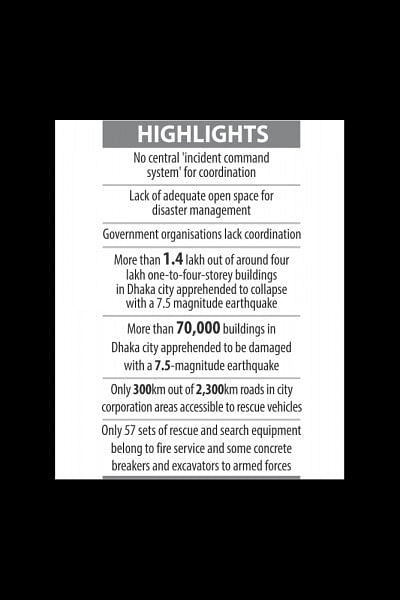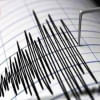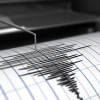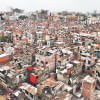Not ready to face catastrophe

With the risk of a major earthquake to cause colossal devastation any time, Bangladesh still lacks elementary awareness with preparedness lying in a deplorable state, according to eminent seismic experts.
Unplanned urbanisation on filled-up marshland and low-lying flood flow zones has left the capital highly vulnerable to earthquake hazards, they warn.
Despite setting a target of creating 62,000 trained rescue volunteers, the six years of second Comprehensive Disaster Management Programme (CDMP) could not train up even half of them, according to Programme Director Md Abdul Qayyum.
A 7.5-magnitude earthquake in or close to Bangladesh territory would result in collapse of or severe damage to more than 70,000 buildings in Dhaka city as per CDMP findings, he says.
“But we have neither elementary lifesaving awareness nor adequate open space for evacuation and medical treatment. Dhaka city lacks open space required for field hospitals to take care of thousands of injured in case of a massive earthquake.
“The open space earmarked in the earthquake contingency plan for Dhaka in some cases has been illegally occupied. The government has to take an uncompromising stance to reclaim, save and find new open space for management of a possible earthquake disaster,” he observes.
Buildings are still being constructed without proper soil tests and compliance with the national building code, leaving those extremely vulnerable to earthquakes, Qayyum adds.
Fourteen government organisations including health, city corporations, fire service, utility service authorities and Rajuk, which have direct links with earthquake disaster management, seem reluctant to put earthquake as a priority agenda, he informs.
Prof Maksud Kamal, chairman of disaster science and management department at Dhaka University, said those organisations lack preparedness as well as coordination with each other with no central “incident command system” for coordination.
He added many of the trained volunteers are going off track, as they know that the organisations do not own them.
According to Prof Kamal, who led the CDMP earthquake technical team, in the event of a 7.5 magnitude earthquake within the Bangladesh territory, more than 1.4 lakh one-to-four-storey masonry buildings in a 300-sqkm area of Dhaka city might collapse.
Brig Gen Ali Ahmed Khan, director general of Fire Service and Civil Defence, echoed the same and added that his department and armed forces have some isolated contingency plans.
Whatever plan is there, it is all on papers, said Ali, adding, it has to be put into ground exercise to see how far it works.
The fire service has 57 sets of rescue and search equipment like cutting tools and drilling hammers. The army also has some heavy equipment like concrete breakers and excavators.
Ali said gas explosion, fire from electricity with chemical warehouses and factories in residential areas, and water contamination following an earthquake might take the situation out of control.
Only 300km out of total 2,300km road network in the city corporations is accessible to fire service rescue vehicles and heavy equipment, he said, adding, even the accessible roads might be blocked in case of building collapse.
Md Shah Kamal, secretary to the disaster management and relief ministry, said 32,000 volunteers for urban areas would be trained under a five-year resilience project.
“We are making a disaster management plan with whatever open space is available. We have already requested the city mayors to reclaim and conserve the designated open space,” he added.
“A devastating earthquake looms large over Bangladesh with the January 4 earthquake being a precursor and a wakeup call for us,” said eminent seismologist and geologist Prof Syed Humayun Akhter.
Two potential sources of major earthquakes in Bangladesh are Dauki fault and the “Fold and Thrust” belt of Chittagong, Myanmar, Manipur, Tripura and Mizoram, he said. The amount of energy caused by India-Burma tectonic plate contraction is trapped along these two sources and is enough to trigger an eight magnitude earthquake, he observed.
The 1548 Assam earthquake and the 1762 Chittagong-Arakan coast great earthquake released a significant amount of energy, but the Feni-Sylhet section of the fault line has not released any energy in the last 1,000 years, he said.
“This section right in the middle of Bangladesh remains the most potential threat of earthquake in the country,” Prof Akhter observed.
Mohammad Abu Sadeque, general secretary of Bangladesh Earthquake Society and director of Housing and Building Research Institute, said preparedness taken so far to respond to earthquake devastation is not worth mentioning.
“It has become evident during dealing with just a single incident of collapse of ten-storey Rana Plaza,” he said.
He suggests that the government should immediately procure early warning devices for auto-trip to shut down electricity, gas and water supply just prior to a jolt to avoid catastrophe caused by fire.
“The state of overall preparedness is very unsatisfactory,” said Mehedi Ahmed Ansary, professor of civil engineering and founding general secretary of Bangladesh Earthquake Society, adding that the government should seek collaboration with professionals and academic institutions to tackle the possible debacle.
The 6.7-magnitude January 4 earthquake with the epicentre in Imphal of Manipur, 353 kilometres off Dhaka, strongly shook Bangladesh. Five people reportedly died of cardiac arrest being panicked and 100 were injured during the jolt.
The World Bank and the UNDP conducted two studies on earthquake impacts in Bangladesh in 2010 and 2012 respectively. The reports estimate about 2-3 lakh people will either die or get injured and the nation would suffer an economic loss of $10 billion.

 For all latest news, follow The Daily Star's Google News channel.
For all latest news, follow The Daily Star's Google News channel. 








Comments